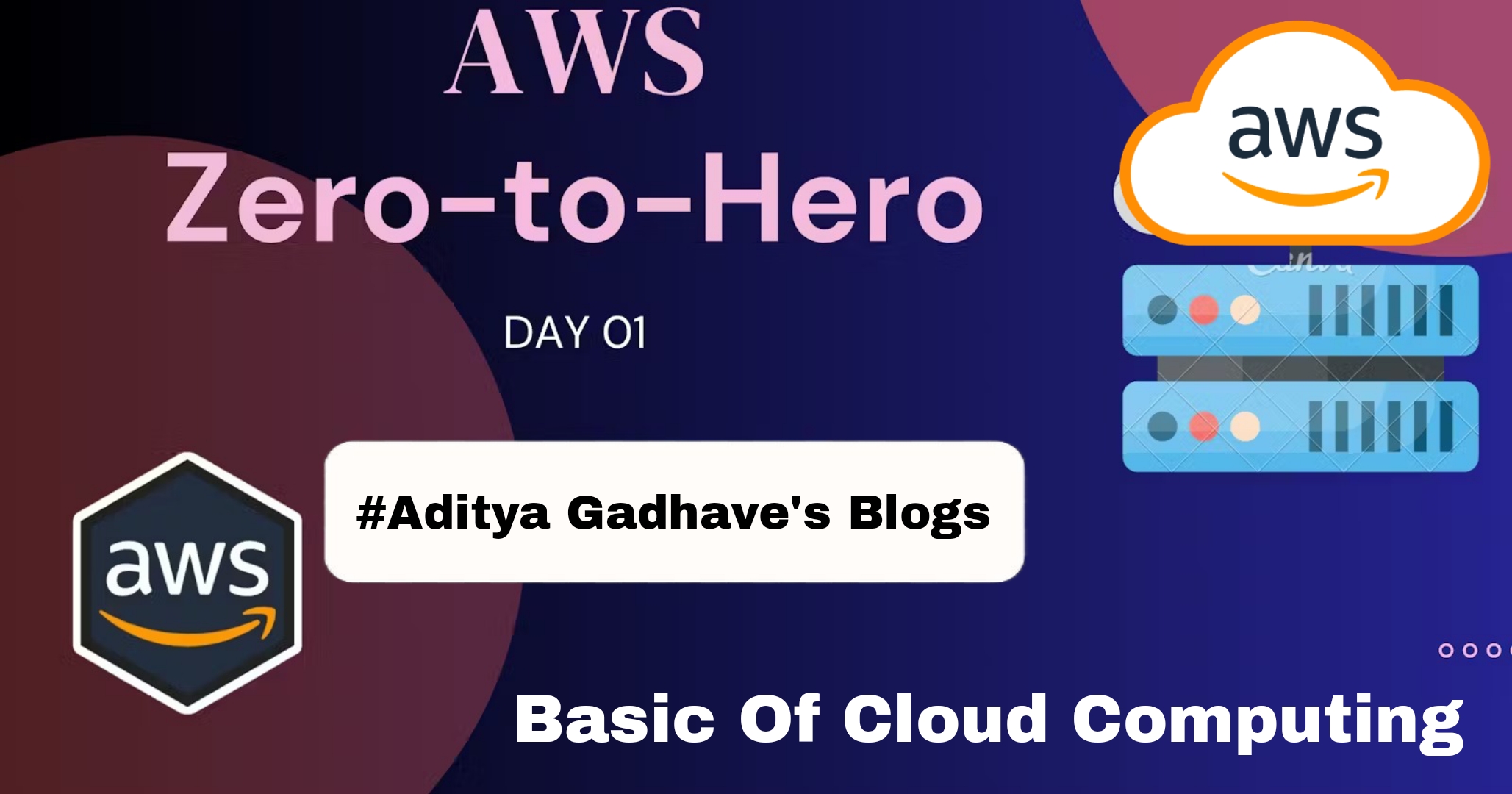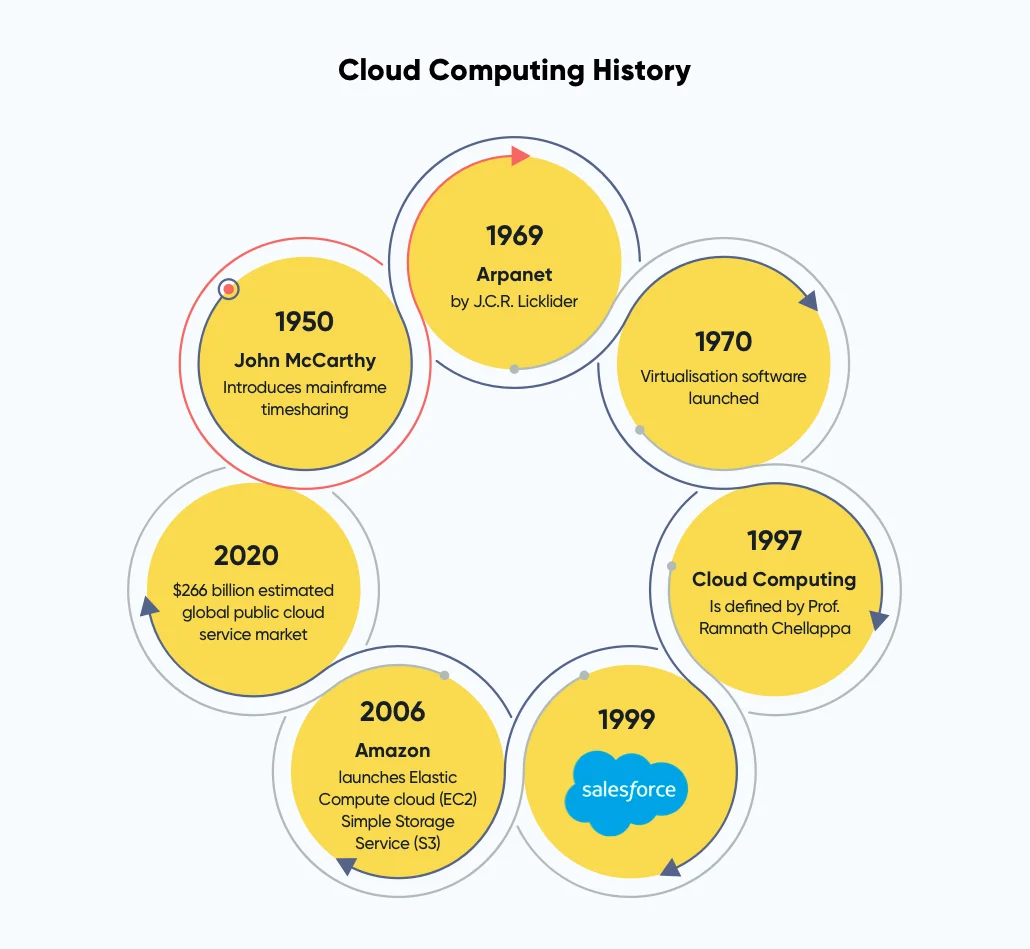Introduction to Cloud Computing: A Beginner's Guide
 Aditya Gadhave
Aditya Gadhave
What is Cloud Computing ?
The term cloud refers to a network or the internet.
It is a technology that uses remote servers on the internet to store, manage, and access data online rather than local drives.
The data can be anything such as files, images, documents, audio, video, and more.
There are the following operations that we can do using cloud computing:
Developing new applications and services
Storage, back up, and recovery of data
Hosting blogs and websites
Delivery of software on demand
Analysis of data
Streaming videos and audios
Why Cloud Computing?
Small as well as large IT companies, follow the traditional methods to provide the IT infrastructure.
That means for any IT company, we need a Server Room that is the basic need of IT companies.
In that server room, there should be a database server, mail server, networking, firewalls, routers, modem, switches, QPS (Query Per Second means how much queries or load will be handled by the server), configurable system, high net speed, and the maintenance engineers.
To establish such IT infrastructure, we need to spend lots of money.
To overcome all these problems and to reduce the IT infrastructure cost, Cloud Computing comes into existence.

History of Cloud Computing
Since the beginning days of computing, when mainframe computers were accessible remotely through terminals, "cloud computing" has evolved.
However, with the development of internet technologies and the demand for more effective and scalable computing solutions in the 1990s and early 2000s, the contemporary idea of cloud computing as we know it today first emerged.

Cloud Computing Architecture :
As we know, cloud computing technology is used by both small and large organizations to store the information in cloud and access it from anywhere at anytime using the internet connection.
Cloud computing architecture is a combination of service-oriented architecture and event-driven architecture.
Cloud computing architecture is divided into the following two parts -
Front End
Back End
The below diagram shows the architecture of cloud computing

Front End
The front end is used by the client. It contains client-side interfaces and applications that are required to access the cloud computing platforms. The front end includes web servers (including Chrome, Firefox, internet explorer, etc.), thin & fat clients, tablets, and mobile devices.
Back End
The back end is used by the service provider. It manages all the resources that are required to provide cloud computing services. It includes a huge amount of data storage, security mechanism, virtual machines, deploying models, servers, traffic control mechanisms, etc.
Cloud Computing Applications
Cloud service providers provide various applications in the field of art, business, data storage and backup services, education, entertainment, management, social networking, etc.
The most widely used cloud computing applications are given below -

Real-World Use Cases
Here are a few examples of how organizations are leveraging cloud computing:
Netflix:
- Uses AWS to stream content to millions of users globally. Cloud scalability allows Netflix to handle varying traffic loads and serve content with minimal downtime.
Spotify:
- Employs Google Cloud for data processing and machine learning to provide personalized music recommendations and manage massive amounts of audio data.
Dropbox:
- Moved from on-premises data centers to AWS for scalable storage infrastructure. Dropbox leverages cloud storage to handle the growing demand for file storage and sharing.
Airbnb:
- Uses cloud infrastructure to support its global operations, providing scalable resources to handle bookings, user data, and real-time search across thousands of locations.
Advantages of Cloud Computing
Cost Efficiency:
No upfront infrastructure costs: Businesses avoid significant capital expenditures on hardware and software.
Pay-as-you-go model: You only pay for the resources you actually use, which can be particularly cost-effective for startups and small businesses.
Reduced IT maintenance costs: Cloud providers handle infrastructure management, reducing the need for in-house IT support and maintenance.
Scalability and Flexibility:
Elastic scaling: Easily scale resources up or down to meet demand. Whether you're dealing with traffic spikes or quieter periods, cloud platforms adjust automatically.
Global reach: Cloud providers operate data centers worldwide, allowing businesses to deploy applications and services globally with low latency.
Business Continuity and Disaster Recovery:
Built-in redundancy: Cloud providers have built-in backups and disaster recovery mechanisms, ensuring data redundancy across multiple locations.
High availability: Cloud services often provide 99.9% uptime or better, reducing the risk of service disruption.
Faster Time to Market:
Quick deployment: With cloud services, businesses can deploy applications and infrastructure rapidly without waiting for physical hardware.
Agility: The ability to launch new services and products quickly gives businesses a competitive edge.
Accessibility and Mobility:
Access from anywhere: Cloud services are accessible from any device with an internet connection, enabling remote work and collaboration.
Multi-device support: Users can access cloud services through desktops, laptops, smartphones, and tablets, improving productivity on the go.
Security:
Advanced security features: Cloud providers invest heavily in security infrastructure, providing encryption, access control, and continuous monitoring.
Compliance certifications: Many cloud platforms adhere to global security and compliance standards (e.g., GDPR, HIPAA, ISO 27001), offering businesses built-in compliance.
Collaboration and Integration:
Real-time collaboration: Teams can collaborate in real-time using shared tools like Google Workspace, Microsoft 365, and Slack, making teamwork more efficient.
Easier integration with other services: Cloud services easily integrate with other systems via APIs, enabling better data exchange and workflows.
Disadvantages of Cloud Computing
Downtime and Service Outages:
Dependence on internet connectivity: Cloud computing requires a reliable internet connection. If connectivity is lost or if the cloud provider experiences downtime, users can't access resources.
Service provider outages: Even major cloud providers like AWS, Google, and Microsoft have experienced service outages, which can disrupt business operations.
Security and Privacy Concerns:
Data security: Storing sensitive information in the cloud raises concerns about data breaches and unauthorized access. While cloud providers offer security measures, no system is completely immune to threats.
Regulatory compliance: Companies in regulated industries (e.g., healthcare, finance) need to ensure that their data is handled in accordance with laws and regulations, which may limit what data can be moved to the cloud.
Limited Control and Flexibility:
Less control over infrastructure: When using cloud services, companies give up control over certain aspects of infrastructure management, such as hardware and software configurations, security settings, and updates.
Customization limits: Some cloud platforms have limitations on customization, which can be a problem for businesses with specific needs or complex legacy systems.
Vendor Lock-In:
Difficult migration: Once a business adopts a specific cloud provider's services, it can be challenging to move to another provider due to differences in platforms, APIs, and data formats.
Potential high switching costs: Moving from one cloud provider to another can be complex, expensive, and time-consuming, potentially locking businesses into a single vendor for the long term.
Hidden and Unpredictable Costs:
Complex pricing models: While cloud computing offers cost savings, the pricing structure can be complex and difficult to predict. If resources are not properly managed, costs can quickly escalate.
Over-provisioning: If a company fails to monitor usage closely, it might pay for resources it doesn’t need or use, negating the financial benefits of cloud computing.
Data Transfer Costs:
- Egress fees: Cloud providers often charge for moving data out of their environment, which can be costly for businesses that need to frequently transfer large amounts of data.
Performance Issues:
Latency: While cloud services can scale globally, accessing data from a geographically distant data center can lead to latency, impacting performance.
Shared resources: Cloud environments are often multi-tenant, meaning resources are shared among multiple users. This can sometimes lead to performance bottlenecks, especially under high demand.
Compliance and Legal Risks:
Data sovereignty: Some countries have strict data localization laws, requiring businesses to store data in the same country. Using cloud services in regions with different regulations may complicate compliance.
Legal ownership of data: Depending on the contract with the cloud provider, questions around data ownership and control can arise, especially in legal disputes.
Challenges of Cloud Computing
While cloud computing offers numerous benefits, there are also challenges, including:
Downtime and Reliability:
- While cloud providers offer high availability, service outages can happen due to network failures or system issues, potentially disrupting business operations.
Data Privacy:
- Storing sensitive data in the cloud raises concerns about regulatory compliance and ensuring that personal and business data is protected from unauthorized access.
Vendor Lock-In:
- Once a company commits to one cloud provider, migrating to another can be difficult due to differences in technologies and APIs, leading to vendor lock-in.
Costs:
- While cloud computing can save upfront infrastructure costs, mismanaged resources (such as over-provisioning) can lead to unexpectedly high cloud bills. Monitoring usage and optimizing resources is critical.
Conclusion
In Conclusion cloud computing is a transformative technology that offers tremendous benefits in terms of cost savings, scalability, flexibility, and accessibility. It empowers businesses to rapidly deploy applications, scale resources as needed, and access global infrastructure without the need for significant upfront investments. The cloud’s ability to enhance collaboration, ensure business continuity, and provide cutting-edge security features further boosts its appeal.
If you have any questions, need clarifications, or want to discuss anything related to AWS technologies, feel free to reach out to me on LinkedIn. Connect with me at Aditya Gadhave, and I'll be more than happy to assist you. 😊
Subscribe to my newsletter
Read articles from Aditya Gadhave directly inside your inbox. Subscribe to the newsletter, and don't miss out.
Written by

Aditya Gadhave
Aditya Gadhave
👋 Hello! I'm Aditya Gadhave, an enthusiastic Computer Engineering Undergraduate Student. My passion for technology has led me on an exciting journey where I'm honing my skills and making meaningful contributions.